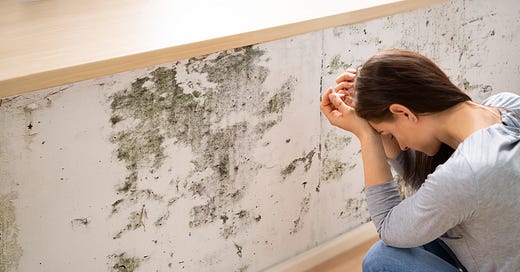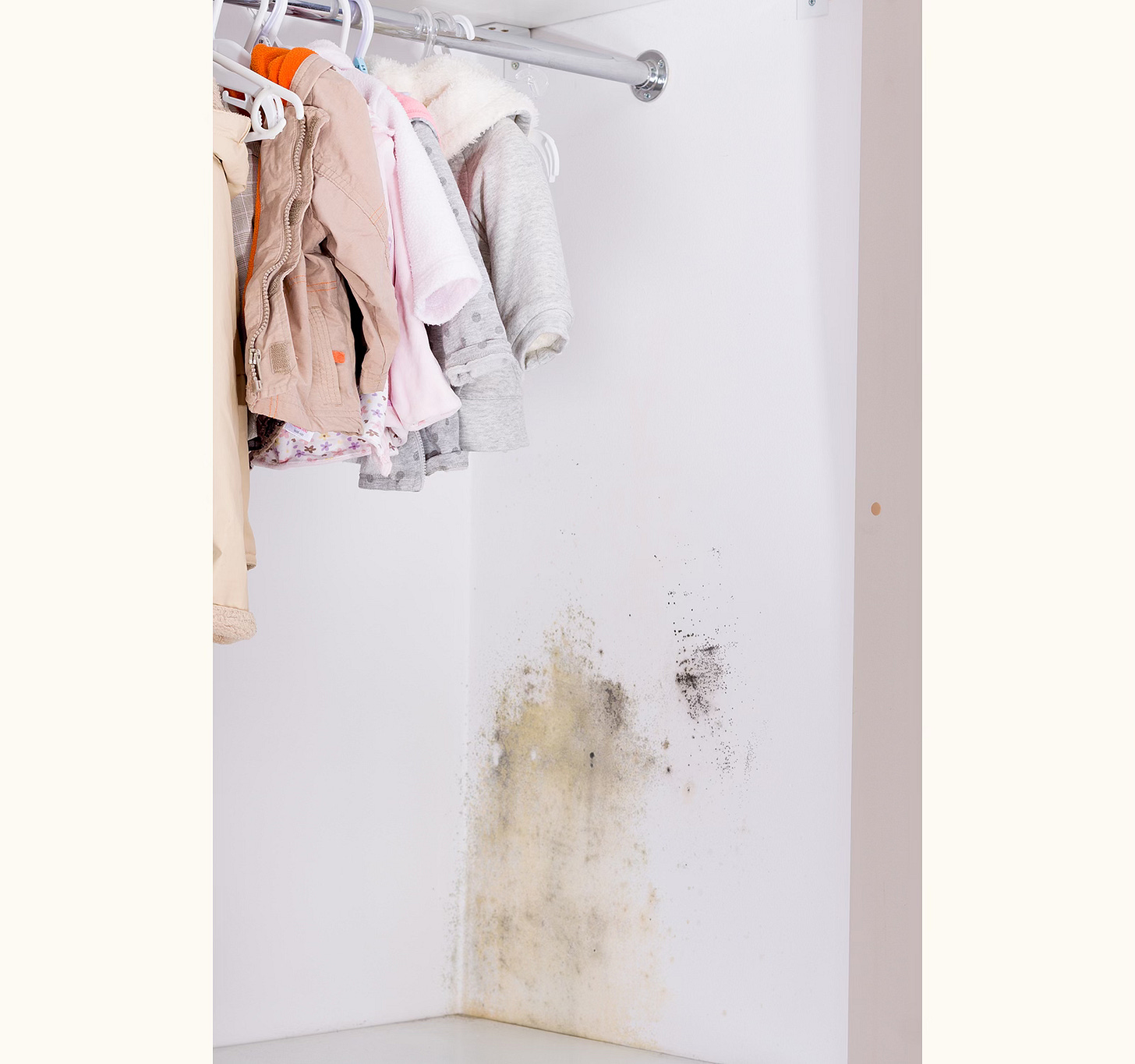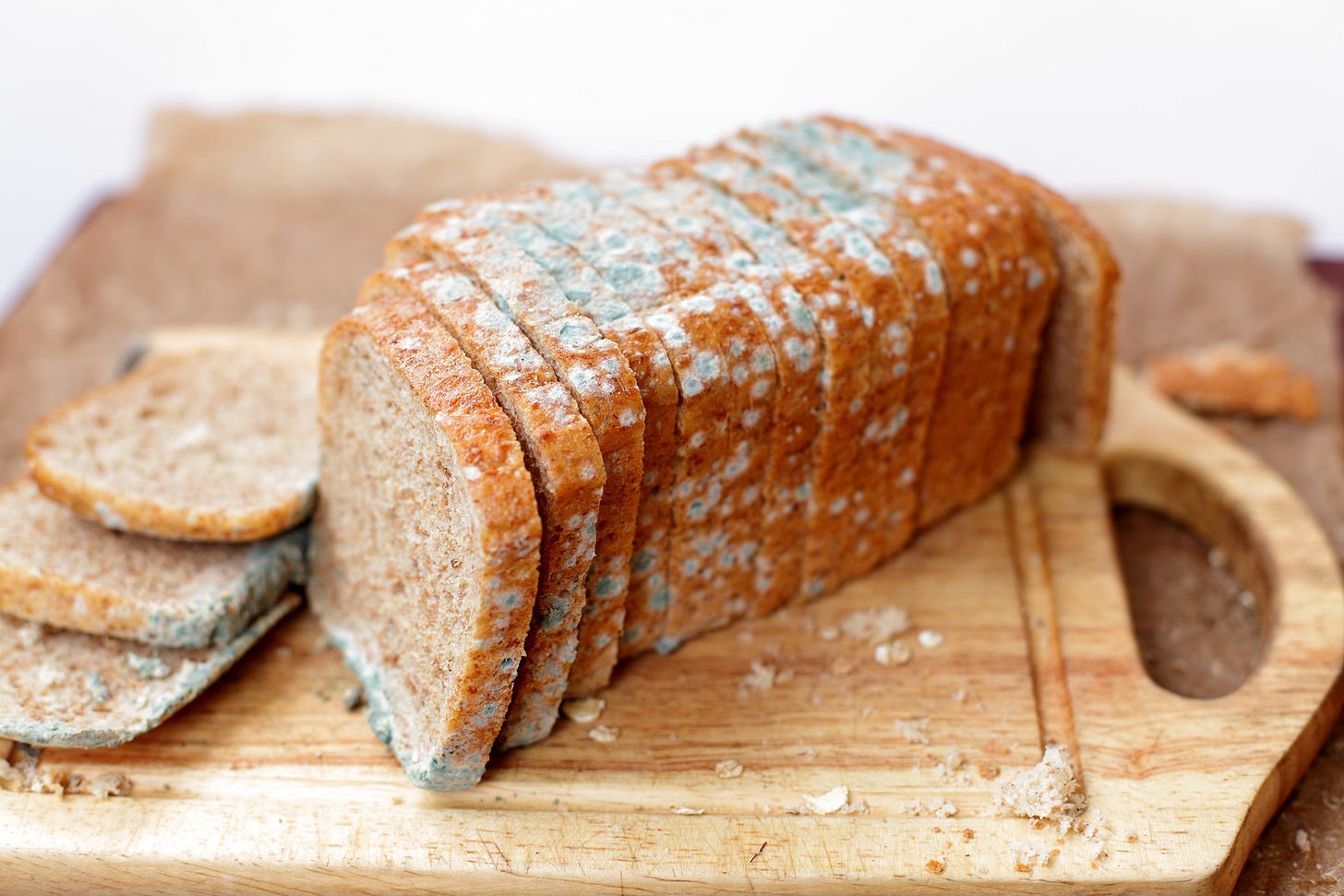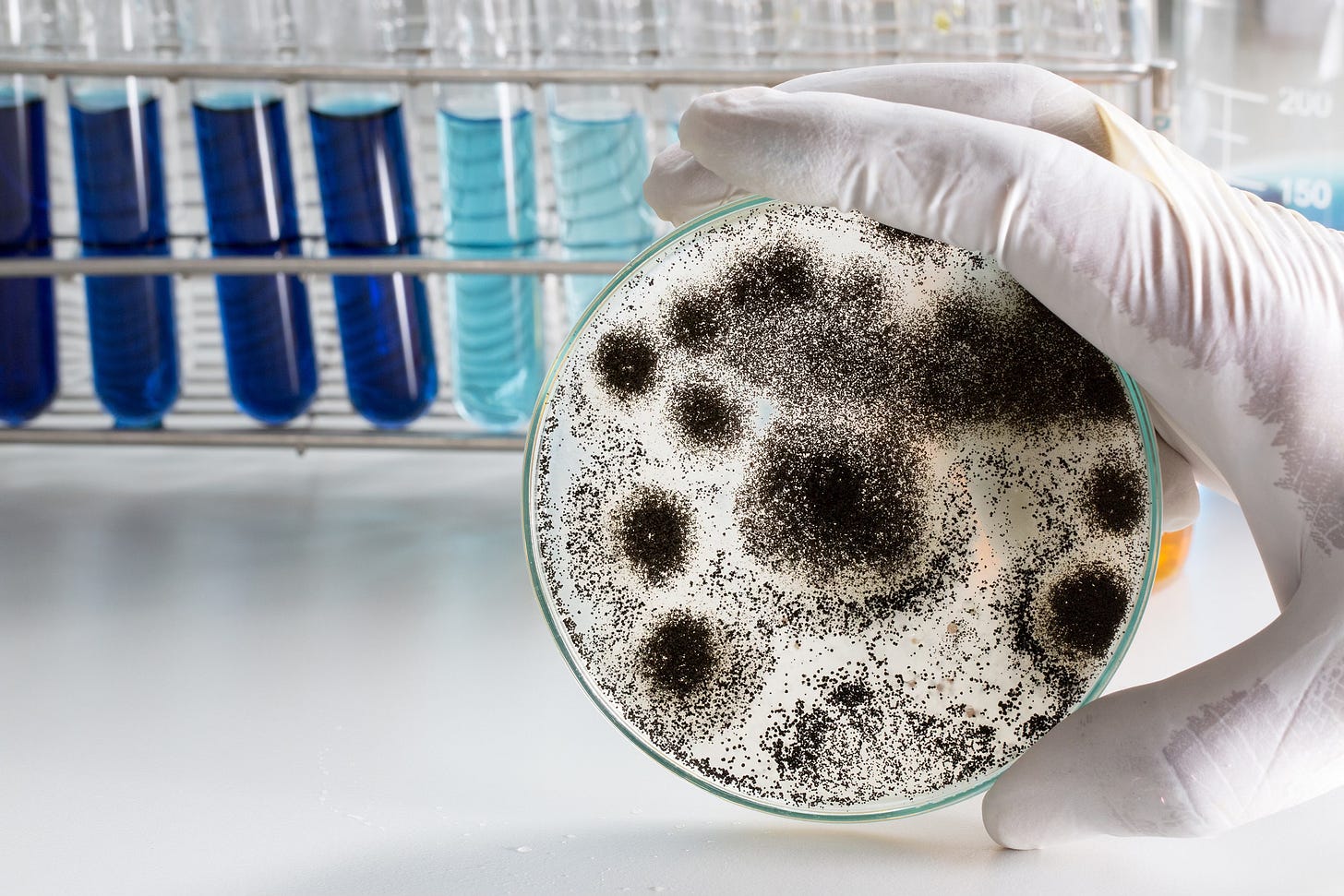Mold Is Everywhere and It Can Make You Sick: Symptoms, Diagnosis, and Treatment of Mycotoxicosis
It’s a moldy world and we’re just living in it.
If you’ve been following my Medical Detective Substacks, you’ve undoubtedly noticed how often I’ve discussed that many symptoms in my chronically ill patients are due to mold toxicity. In fact, mold toxicity is now showing up in approximately 80-90% of these patients.
If you suffer with chronic Lyme disease and associated co-infections, it is extremely important to be evaluated for mold toxins. Why? Because mycotoxins can and do interfere with the success of dapsone combination therapy. Partly because mold toxins suppress your immune system and make it much more difficult to properly address chronic infections; and partly but because they cause overlapping symptoms seen in Lyme and associated disorders. In fact, every chronic Lyme disease symptom (except for migratory joint, muscle, and nerve pain, the hallmarks of active Lyme disease) can be seen in mold-toxic individuals. If you have had a biofilm/persister drug regimen like dapsone combination therapy which is highly effective in the majority of our patients, yet still have chronic persistent symptoms (apart from other infections including Babesia and Bartonella) think mold toxicity as one potential cause.
What Are the Classic Symptoms of Mold Toxicity?
Apart from a chronic fatiguing, musculo-skeletal, neurological illness, you can develop:
Respiratory symptoms (a chronic cough, wheezing, nasal congestion, and sinusitis) as mold can exacerbate asthma and allergic rhinitis.
Headaches are also common with cognitive dysfunction, memory loss, and mood disorders.
Gastrointestinal symptoms with nausea and diarrhea are possible.
Chronic Inflammatory Response Syndrome (CIRS) is a common systemic manifestation. You don’t want mold suppressing your immune system and being a separate source of inflammation, contributing to chronic resistant symptoms.
Where Is the Mold Coming From?
Mold it commonly found in environments that have sustained water damage, often in current/ past residences and workplaces where leaks have happened that you don’t know about:
Basements with high humidity, water sources, poor ventilation, musty odors, efflorescence, or visible mold have significantly higher fungal concentrations.
Bathrooms, due to the constant presence of water and high humidity. There can also be leaks. Inadequate ventilation exacerbates the problem, leading to mold growth on walls, ceilings, and tiles.
Kitchens can harbor mold, especially around the sink, under cabinets, and in areas with water leaks or spills. The combination of moisture and organic materials provides an ideal environment for mold proliferation.
Attics are susceptible to mold growth due to roof leaks, poor or inadequate ventilation, and mold can easily grow on wooden structures and insulation materials.
Crawlspaces also have high humidity and poor ventilation.
Laundry rooms develop mold due to the presence of water and humidity from washing machines and dryers.
HVAC systems. Condensation in those areas with water leaks can lead to the spread of mold spores throughout the building. You will usually need a certified mold inspection company to come in and examine your home if you have tested positive for mycotoxins to ensure that you are not being constantly exposed. Check in your area for a qualified company.
Will I Have to Get Out of My House If There Is Significant Contamination?
The answer depends on how sick you are, how bad the toxin levels are, and how well your detoxification systems are working. Some people will not heal if they stay in a very moldy environment, and some of my patients have needed to do so. There are doctors who advise throwing away all clothing that have been exposed. I don’t usually advise such radical measures, but in rare cases, it may be necessary. I would get a second opinion from Dr Neil Nathan or Dr Jill Crista, who are mold experts, before having to throw out all your belongings!
One doctor I have treated, who was so sick for a decade that she couldn’t work, got to 100% normal functioning after her first 9-week double-dose dapsone/high dose dapsone protocol. She applied for her medical license as she felt so well! Yet when she got back into her home, which she didn’t realize was loaded with mold, noticeable symptoms returned (although she remained at roughly 95% of normal). Any patient who says they get sick going into their home, and feels better out of the home, usually is either chemically sensitive, and/or mold sensitive and needs a clean environment in order to heal.
Apart from My Home or Work, Can I Also Get Mold from Contaminated Food Sources?
Yes, it is possible. Although some mold experts don’t feel it is a significant source of exposure, low levels of mycotoxins are found in many foods. Approximately 25% of the world’s crops, such as cereals, nuts, and rice, are mold-contaminated. Mold can also be found in foods including fruits, meat, wine, beer, coffee, etc. In some cases, foods can contribute to mycotoxin illness, especially certain molds such as Aspergillus, Fusarium, and Penicillium, which can contaminate foods such as dairy products, dried fruits, coffee, cereals and nuts.
What Can I Eat on a Low Mold Diet?
If you are significantly mold sensitive, and have high levels, it is very reasonable to follow a low mold diet. This will prevent further accumulation of mycotoxins in your body and reduce exposure by decreasing simple carbohydrates that feed Candida and yeast. Key components of a low mold diet include avoiding high-risk foods that are commonly contaminated with mold and mycotoxins. These foods should be limited or avoided:
Grains (especially corn, oats and wheat)
Nuts (particularly peanuts and pistachios, but also walnuts and Brazil nuts),
Certain dairy products (aged cheese, sliced or block cheese, sour cream, buttermilk)
All simple sugars (candies, cakes, pies, molasses, honey, maple syrup, fructose, mannitol)
Sweet fruits (mangoes, watermelon, melons, pineapple, grapes, oranges) and dried fruits
Coffee.
You also want to choose fresh, whole foods. Organic is always preferable to reduce pesticide exposure which can stress the detoxification pathways. You also want to store food in dry, cool conditions to prevent mold growth and refrigerate perishable items and use airtight containers to protect against moisture. Foods to include:
Fresh organic fruits and vegetables
Lean proteins
Whole grains that are less likely to be contaminated.
I also advise my patients to stay on a very low-carbohydrate diet in general, because at least half of my patients have blood sugar swings with reactive hypoglycemia/metabolic syndrome (a precursor of diabetes). Also, simple carbohydrates can increase Candida overgrowth in the gut, causing similar symptoms to what we see with chronic Lyme and associated co-infections. A Mediterranean-style diet with 40% good quality protein/30% complex carbohydrates/30% healthy fats (extra virgin organic olive oil/avocado), while eating small frequent meals throughout the day, is usually a good place to start. (This is also a heart-healthy diet.)
Testing for Mycotoxins
There are several different ways of testing for mold toxins. I have listened to Dr. Neil Nathan teach on mold toxicity, and the primary test he advises, which is the one that I use, is the urine test from Real Time Laboratory in Texas. This test measures the actual body burden of mycotoxins. I give my patients 2000 mg of glutathione one hour before doing the urine test, drinking an 8-ounce glass of water every 15 minutes to adequately hydrate; 15-20 minutes before doing the test, I advise my patients to get in a sauna and have a light sweat to mobilize the toxins before urinating to do the test. This is extremely important because those who don’t take glutathione or sweat have had lower levels of toxins; when I repeated the test with glutathione and sweating, the toxin levels were significantly higher. Other doctors may use different screening techniques, but this one has been effective in finding mold in our patients.
I also regularly check a nasal swab for mold spores and biofilms through Microbiology DX if the mycotoxins are positive from Real Time Laboratory. Colonization of the sinuses and G.I. tract can happen with mold spores, where you then become the “moldy building,” and the exposure comes from an internal, not external, source. If patients do test positive for mold spores/biofilms in their sinuses, a compounded nasal spray by Infuserve in Florida directly addresses the type of mold/biofilm. Some healthcare practitioners like Dr. Nicola Ducharme, ND, will, however, typically start with a natural nasal spray (like colloidal silver or Xlear, which is xylitol based), or add a few pumps of their Biocidin LSF to the entire bottle of colloidal silver nasal spray, just to give it an extra boost. Dr. Jill Crista, another mold expert, likes steam inhalations with thyme essential oil. She does this to open up the sinuses while having an overlapping antifungal effect.
Regarding blood tests, some doctors like Great Plains Laboratory and other functional medicine laboratories as another way of testing for mold exposure. Blood serum testing for mycotoxin antibodies have been used for the last 25 years and are considered to be highly accurate. The specificity and sensitivity of blood serum testing for the presence of IgG and IgE antibodies to common mycotoxins in the blood are reliable, but don’t tell you the actual amount of mold in your body, which is why we primarily rely on Real Time Laboratory (and we can’t do some of these other functional medicine laboratory tests in NY!).
A Simplified Mold Detoxification Protocol
The protocol listed below is the one I frequently use for my patients with good results. Your healthcare provider may prefer to use treatments including cholestyramine, but due to its frequent gastrointestinal side effects, I prefer to use binders including charcoal and clay as well as glucomannan for trichothecenes. This protocol is generally well-tolerated and effective. There can occasionally be some constipation using binders, but increasing fluids and magnesium usually will help avoid the side effects. You need your bowels to be moving regularly to properly detoxify.
Take these supplements. Except where noted, all of them can be taken at the same time, such as after breakfast and dinner:
NAC 600 mg 2x/day
Alpha lipoic acid (ALAMAX, Xymogen) 600 mg, 1 2x/day (the dose may need to be adjusted downward for those with reactive hypoglycemia)
Glutathione 500 mg 2x/day
BioPC Pro (Ortho Molecular), 1 scoop 2x/day (or Phosphaline, 1 teaspoon 2x/day, Xymogen) with BodyBio Sodium D-butyrate 500 mg 2x/day
MinRx 2 twice a day (Xymogen)
Magnesium malate, 2-4 capsules 2x/day (NutramediX)
Saccharomyces boulardii (Orthomolecular) 1 capsule 2x/day (take first thing in the morning upon awakening and last thing at night),
If there is any constipation, we increase the magnesium. Once this is tolerated, we may consider increasing the dose of the GI detox to speed things up….
Binders must be taken between 1-2 hours away from all medications, supplements and food:
To pull out trichothecenes, take glucomannan, 1 scoop 1x/day (in between breakfast and lunch, around 11 a.m.; Xymogens Optifiber Lean is the primary one we use),
To pull out the rest of the mold toxins, take GI detox (BioBotanical Research), 1x/day to start (2 hours away from meds and supplements, around 3:30 p.m. in the afternoon). If there are high levels of mycotoxins and one GI detox is tolerated, without constipation, we may increase the dose to 2 capsules midday (some individuals may get ill using higher doses of binders when they start, as their detoxification pathways are clogged up; and highly mold sensitive individuals will need to use much lower doses of binders, sometimes a ‘fraction’ of the dose, building up slowly).
In addition, I advise patients to drink lots of fluids, and, if available, to use far-infra-red saunas and sweat, which will help to mobilize the toxins and increase excretion. This can be done throughout the time you are detoxing mold (and afterwards, considering the hundreds to thousands of environmental chemicals getting into everyone’s bodies these days). You have to be careful however to not overdo saunas if you have POTS/dysautonomia with low blood pressure (I don’t advise more than 15-20 minutes with a light sweat), and/or detoxification pathways that are not working well. Always check with your healthcare provider regarding your individual needs.
If systemic mold is suspected, and mold spores are present in the sinuses/GI tract, then an oral anti-fungal like itraconazole will be necessary. The recommended dose is usually 200 mg once a day but can go up to 200 mg twice a day for severe systemic mold (although that dose is usually more for moderate to severe fungal infections like histoplasmosis) for at least one month, possibly two. Other anti-fungal treatments include Amphotericin B, posaconazole (where itraconazole is not tolerated) or voriconazole. You will need to discuss these with your physician, as there are potential side effects that need to be considered for each medication, although they can be highly effective in resistant cases. For more detailed information on how to treat mold in the highly sensitive patient, I would suggest reading Dr Neil Nathan’s books, Mold and Mycotoxins: Current Evaluation and Treatment 2016 (just updated, as an e-book, Mold and Mycotoxins 2022) and Toxic: Heal Your Body from Mold Toxicity, as well as the Sensitive Patient’s Healing Guide. My patients are usually not as sensitive as Dr Nathan’s, based on our prior conversations, just like his patients don’t usually have as much severe Lyme, Babesia and Bartonella as mine! We have learned from each other over time. Also, Dr Jill Crista has an excellent mold book, “Break the Mold: 5 Tools to Conquer Mold and Take Back Your Health”. You will find other clues to helping clear mold toxins in Dr Jill’s book. They are both excellent reference guides.
Most patients have mold levels rechecked after roughly 6 months, but the timing will depend on the mycotoxin load. You will also need to check a CBC, CMP with liver functions, and mineral levels (serum and RBC minerals, i.e., magnesium, copper, zinc, iodine) when you are detoxing to ensure you are not pulling out essential minerals at the same time. Many people add extra liver support (milk thistle, sulforaphane glucosinolate, DIM), Nrf2 activators (curcumin, resveratrol, organic green tea), and supplements (low-dose naltrexone, low-dose melatonin) that block NLRP3 inflammasomes, a third inflammatory pathway while doing mold detoxification. This helps support a healthy inflammatory response and assist detoxification. You will also likely require mitochondrial regeneration once done, as mycotoxins can damage fragile mitochondrial membranes. My prior Substacks on Bartonella, describe how to do mitochondrial regeneration at the end of dapsone combination therapy.
I hope you have found this mold overview useful. It is an essential part of the healing process at the HVHAC. Please feel free to share this Medical Detective Substack widely and remember to stay tuned for the Healing Lyme Summit 2.0, where I interview Dr. Jill Crista and she explains her approach to mycotoxin illness. You will also hear from Dr. Nicola Ducharme at the Doctor Talk Healing Lyme Summit, scheduled mid-April 2025. It is free to attend, and as a bonus, there will be nine new stories in this year’s dapsone documentary with people who are now well, after treating Lyme, Babesia and Bartonella, where mold was a factor in their healing process. To your health….









